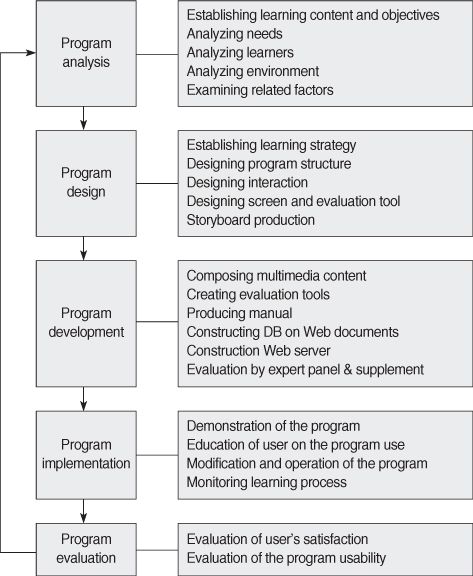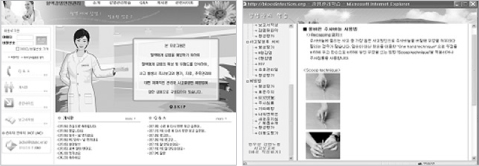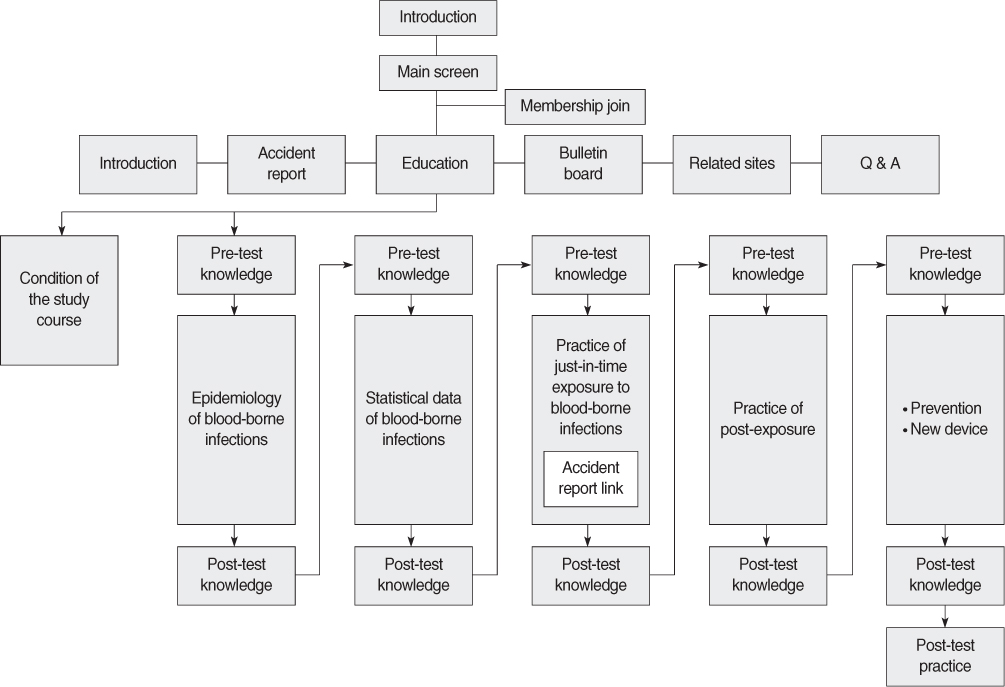Application and Evaluation of a Web-based Education Program on Blood-borne Infection Control for Nurses
- Affiliations
-
- 1Department of Nursing Science, Konyang University, Daejeon, Korea. jschoi408@empal.com
- 2Department of Nursing, Seoul National University, Seoul, Korea.
- KMID: 1405632
- DOI: http://doi.org/10.4040/jkan.2009.39.2.298
Abstract
- PURPOSE
To develop a web-based program on blood-borne infection control and to examine the effect of the newly developed program on perceived threat of diseases, knowledge, preventive health behaviors for blood-borne infections, and incidence rates of accidental needle sticks and other sharp object injuries in nurses. METHODS: The program was developed through the processes of analysis, design, development, implementation, and evaluation. The research design involved a nonequivalent control group for pretest and posttest experiments. The setting was a 745-bed general hospital located in Korea. RESULTS: The program was designed and developed after consulting previous studies. After development of the program was completed, it was evaluated and revised by a panel of experts. The total score for perceived threat of diseases, knowledge, preventive health behaviors in the experimental group was significantly higher compared to the control group (p<.05). The incidence rates for needle sticks and other sharp object injuries in the experimental group were significantly lower compared to the control group (p<.05). CONCLUSION: Application of a Web-based, blood-borne infection control program is effective, and can be expanded to other healthcare workers who also have a high risk of blood-borne infections.
Keyword
MeSH Terms
Figure
Cited by 4 articles
-
Effects of a Web-Based Korean Triage and Acuity Scale Learning Program on Triage Self-Efficacy and Triage Performance Ability for Nurses in Emergency Department
Hyo-Jin Kim, Hee-Young Kang
J Korean Acad Nurs. 2019;49(2):171-180. doi: 10.4040/jkan.2019.49.2.171.Development of a Web-based Diagnostic Evaluation Program for Prevention of Nurse Malpractice Liability
Ki-Kyong Kim
J Korean Acad Nurs Adm. 2011;17(1):33-43. doi: 10.11111/jkana.2011.17.1.33.Seroprevalence of Anti-hepatitis B Virus, Anti-hepatitis A Virus, and Anti-varicella Zoster Virus Antibodies in Nursing Students from 2009 to 2013
Park Jin-Hee, Shon Joung-A
Korean J Nosocomial Infect Control. 2013;21(1):31-36. doi: 10.14192/kjnlc.2016.21.1.31.Knowledge and Educational Need of Central Supply Room Nurses for the Sterilization Process
Hyun Yun Ji, Sook Jeong Ihn
Korean J Nosocomial Infect Control. 2013;20(2):70-81. doi: 10.14192/kjnic.2015.20.2.70.
Reference
-
1. Agius RM, Bagnall G. Development and evaluation of the use of the Internet as an educational tool in occupational and environmental health and medicine. Occupational Medicine. 1998. 48:337–343.2. Ahn SK. A study on user's satisfaction of agriculture on information system. 1999. Seoul: Seoul National University;Unpublished master's thesis.3. Association for Professionals in Infection Control and Epidemiology. APIC text of infection control and epidemiology. 2005. Washington DC: Association for Professionals in Infection Control and Epidemiology.4. Becker MH, Janz NK, Band J, Bartley J, Snyder MB, Gaynes RP. Noncompliance with universal precautions policy: Why do physicians and nurses recap needles? American Journal of Infection Control. 1990. 18:232–239.5. Centers for Disease Control and Prevention. Updated U.S. Public Health Service guideline for the management of occupational exposure to HBV, HCV, and HIV and recommendation for postexposure prophylaxis. Morbidity and Mortality Weekly Report. 2001. 50(11):1–52.6. The national surveillance system for hospital health care workers: Summary report for data collected from June 1995 through July 1999. Centers for Disease Control and Prevention. 2003. 12. 05. Retrieved November 1, 2006. from http://www.cdc.gov/ncidod/hip/NASH/report99.pdf.7. Choi JS. A study on KAP of medical personnel against exposure to the patient's bloods and fluids in special departments of a general hospital. 1998. Seoul: Seoul National University;Unpublished master's thesis.8. Davidson G, Gillies P. Safe working practices and HIV infection: Knowledge, attitudes, perception of risk, and policy in hospital. Quality in Health Care. 1993. 2:21–26.9. Doll WJ, Torkzadeh G. The measurement of end-user computing satisfaction. Management Information Systems Quarterly. 1988. 12:259–274.10. Gaston G, Hermine N, Christian F. Understanding physician's intention to use a simple infection control measure: Wearing gloves. American Journal of Infection Control. 1998. 26:413–417.11. Hege I, Radon K, Dugas M, Scharrer E, Nowak D. Web-based training in occupational medicine. International Archives of Occupational and Environmental Health. 2003. 76:50–54.12. Hentgen V, Jaureguiberry S, Ramiliarisoa A, Andrianantoandro V, Belec M. Knowledge, attitude and practices of health personnel with regard to HIV/AIDS in Tamatave (Madagascar). Bulletin de la Societe de Pathologie Exotique. 2002. 95:103–108.13. Honghong W, Kristopher F, Guoping H, Jane B., Williams AB. A training program for prevention of occupational exposure to bloodborne pathogens: Impact on knowledge, behavior and incidence of needle stick injuries among student nurses in change, people's Republic of China. Journal of Advanced Nursing. 2003. 41:187–194.14. EPINetTM*: Uniform needlestick and sharp object injury report in 21 hospitals, 2003. International Health Care Worker Safety Center. 2005. 12. 05. Retrieved November 1, 2006. from http://www.med.virginia.edu/medcntr/centers/ epinet/soi99.html.15. Jennifer ME, Marc FB, Nicholas X, Lars N. Needlestick injuries in the United States. Official Journal of the American Association of Occupational Health Nurses. 2005. 53:117–133.16. Jung YM. Development of a wed-based senescence preparation education program for successful aging for middle-aged adults. Journal of Korean Academy of Nursing. 2008. 38:831–842.17. Kim JS. Development and evaluation of a web-based program for maternal role support of the primiparas. 2003. Seoul: Seoul National University;Unpublished doctoral dissertation.18. Kim KK, Kim MA, Chung YS, Kim NC. Knowledge and performance of universal precautions by nursing students. Journal of Korean Academy of Nursing. 1999. 29:929–939.19. Kim MH. Health belief model approach to health beliefs, attitude, and health behaviors concerning HIV/AIDS. Journal of Korean Society Health Education and Promotion. 1997. 14:125–147.20. Kim MO. A study on a design for interface screen of web-based cyber study instruments. 2001. Seoul: Hannam University;Unpublished master's thesis.21. Kim OS. Risk factor and incidence of needlestick injuries among hospital employees. 1997. Seoul: Yonsei University;Unpublished master's thesis.22. Kim OS. Development and effectiveness of a prevention model of bloodborne disease exposure among health care worker. 2003. Seoul: Yonsei University;Unpublished doctoral dissertation.23. Lunding S, Nielsen TL, Nielsen JO. Poor compliance with universal precautions among Danish physicians. Ugeskrift for Laeger. 1998. 160:1789–1793.24. Park MR, Kim JE, Park ES, Choi JS, Jung SY, Song YG, et al. A multicenter descriptive study of bloodborne exposures among health care workers in Seoul and Gyeonggi-Do. Korean Journal of Nosocomial Infection Control. 2003. 8:35–45.25. Radon K, Kolb S, Reichert J, Baumeister T, Fuchs R, Hege I, et al. Case-based e-learning in occupational medicine? the NetWoRM project in Germany. Annals of Agricultural and Environmental Medicine. 2006. 13:93–98.26. Ramsey PW, Glenn LL. Nurses' body fluid exposure reporting, HIV testing, and hepatitis B vaccination rates: Before and after implementing universal precautions regulations. Official Journal of the American Association of Occupational Health Nurses. 1996. 44:129–137.27. Ryan ME, Jones L, Miller D. Healthcare workers and bloodborne pathogens: Knowledge, concerns and practices. Gastroenterology Nursing. 1996. 19:96–101.28. Shin SJ, Shin KR, Yi HR, Ju SK. Knowledge, health belief, and self-efficacy related to osteoporosis. Journal of Korean Academy of Nursing. 2005. 35:850–857.29. Tina M. Just-in-time training: A web-based tool for needlestick injury. Joint Commission Journal on Quality and Patient Safety. 2004. 29:201–206.30. Zafar AB, Butler RC, Podgorny JM, Mennonna PA, Gaydos LA, Sandiford JA. Effect of a comprehensive program to reduce needlestick injuries. Infection Control and Hospital Epidemiology. 1997. 18:712–715.
- Full Text Links
- Actions
-
Cited
- CITED
-
- Close
- Share
- Similar articles
-
- Development and Evaluation of an e-learning Blood-borne Infection Control Program for Nursing Students
- Knowledge on Blood-Borne Infection, Awareness and Compliance on Blood-Borne Infection Control, and Factors Influencing Compliance among Emergency Nurses
- Knowledge on Blood-borne Infections, Compliance and Barriers on Blood-borne Infection Control among Nurses in Hemodialysis Units
- Effects of Web-based Program for Evidence-Based Nursing Education on Knowledge and Learning Motivation in Nurses
- Development and Evaluation of a Web-based Education Program for Nursing Students on Control of Vancomycin-resistant Enterococcus Infection




